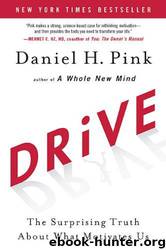Drive by Pink Daniel H

Author:Pink, Daniel H. [H., Pink, Daniel]
Format: epub
ISBN: 1594488843
Published: 2010-06-03T04:00:00+00:00
Drive
CHAPTER 5
Mastery
You need not see what someone is doing to know if it is his vocation,
you have only to watch his eyes: a cook mixing a sauce, a surgeon
making a primary incision, a clerk completing a bill of lading,
wear the same rapt expression, forgetting themselves in a function.
How beautiful it is, that eye-on-the-object look.
W. H. Auden
O ne summer morning in 1944, Mihaly Csikszentmihalyi, age ten, stood on a train platform in Budapest, Hungary, with his mother, two brothers, and about seventy relatives who'd come to see them off. World War II was raging, and Hungary, an ambivalent member of the Axis, was being squeezed from every political and geographic corner. Nazi soldiers were occupying the country in retaliation for Hungary's secret peace negotiations with the United States and Great Britain. Meanwhile, Soviet troops were advancing on the capital city.
It was time to leave. So the foursome boarded a train for Venice, Italy, where Csikszentmihalyi's father, a diplomat, was working. As the train rumbled southwest, bombs exploded in the distance. Bullets ripped through the train's windows, while a rifle-toting soldier on board fired back at the attackers. The ten-year-old crouched under his seat, terrified but also a little annoyed.
It struck me at that point that grown-ups had really no idea how to live, Csikszentmihalyi told me some sixty-five years later.
His train would turn out to be the last to cross the Danube River for many years. Shortly after its departure, air strikes destroyed Hungary's major bridges. The Csikszentmihalyis were well educated and well connected, but the war flattened their lives. Of the relatives on the train platform that morning, more than half would be dead five months later. One of Csikszentmihalyi's brothers spent six years doing hard labor in the Ural Mountains. Another was killed fighting the Soviets.
The whole experience got me thinking, Csikszentmihalyi said, recalling his ten-year-old self. There has got to be a better way to live than this.
FROM COMPLIANCE TO ENGAGEMENT
T he opposite of autonomy is control. And since they sit at different poles of the behavioral compass, they point us toward different destinations. Control leads to compliance; autonomy leads to engagement. And this distinction leads to the second element of Type I behavior: mastery the desire to get better and better at something that matters.
As I explained in Part One, Motivation 2.0's goal was to encourage people to do particular things in particular ways that is, to get them to comply. And for that objective, few motivators are more effective than a nice bunch of carrots and the threat of an occasional stick. This was rarely a promising route to self-actualization, of course. But as an economic strategy, it had a certain logic. For routine tasks, the sort of work that defined most of the twentieth century, gaining compliance usually worked just fine.
But that was then. For the definitional tasks of the twenty-first century, such a strategy falls short, often woefully short. Solving complex problems requires an inquiring mind and the willingness to experiment one's way to a fresh solution.
Download
This site does not store any files on its server. We only index and link to content provided by other sites. Please contact the content providers to delete copyright contents if any and email us, we'll remove relevant links or contents immediately.
| Ethics | Etiquette |
| Fashion & Image | Health & Stress |
| Motivation & Self-Improvement | Work Life Balance |
| Workplace Culture |
Tools of Titans by Timothy Ferriss(8295)
Change Your Questions, Change Your Life by Marilee Adams(7672)
Deep Work by Cal Newport(6951)
Playing to Win_ How Strategy Really Works by A.G. Lafley & Roger L. Martin(6067)
Man-made Catastrophes and Risk Information Concealment by Dmitry Chernov & Didier Sornette(5947)
Digital Minimalism by Cal Newport;(5695)
Big Magic: Creative Living Beyond Fear by Elizabeth Gilbert(5671)
The Slight Edge by Jeff Olson(5373)
Ego Is the Enemy by Ryan Holiday(5340)
The Motivation Myth by Jeff Haden(5170)
The Laws of Human Nature by Robert Greene(5055)
Stone's Rules by Roger Stone(5046)
Tuesdays with Morrie by Mitch Albom(4723)
Eat That Frog! by Brian Tracy(4477)
Rising Strong by Brene Brown(4405)
Skin in the Game by Nassim Nicholas Taleb(4198)
Bullshit Jobs by David Graeber(4130)
The Money Culture by Michael Lewis(4122)
Skin in the Game: Hidden Asymmetries in Daily Life by Nassim Nicholas Taleb(3958)
